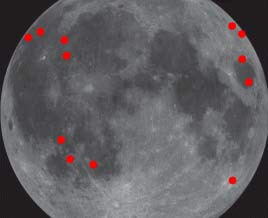Potential Danger: Moon Hit By More Space Rocks Than Thought

Potentially dangerous small space rocks are smashing into the Moon a lot more often than was expected, according to an ongoing NASA study.
"We've now seen 11 and possibly 12 lunar impacts since we started monitoring the Moon one year ago," said Bill Cooke, head of NASA's Meteoroid Environment Office. "That's about four times more hits than our computer models predicted."
If further study proves the pace to be accurate, it could figure into plans for putting people on the Moon, according to a NASA statement issued today.
A collision with a spacesuit or a habitation module, even from a small object, could be fatal.
Most meteoroids that enter Earth's atmosphere burn up harmlessly. The bulk of shooting stars are caused by stuff no bigger than sand grains and a few pea-sized objects. But even something as big as a basketball will usually burn up, in a spectacular fireball, before hitting Earth's surface.
The Moon, with no atmosphere, sees it all rain down.
Cooke and colleagues spotted a very bright lunar impact last December. They documented two impacts during last month's Leonid meteor shower.
Get the Space.com Newsletter
Breaking space news, the latest updates on rocket launches, skywatching events and more!
"The flashes we saw were caused by Leonid meteoroids 2 to 3 inches (5 to 8 cm) in diameter," Cooke said today in a NASA statement. They hit with energies equal to 150 to 300 pounds of TNT.
Leonid meteors, leftover chunks from a comet, are particularly dangerous because they move against the path of our own orbit around the Sun, so we hit them head-on at greater speed than much other debris. This results in a greater release of energy at impact.
"We need to spend more time watching the Moon," Cooke said. "With more data, we can draw stronger conclusions about the impact rate."
- Images: The Moon
- Small Space Rock Spotted Hitting the Moon
- Moon Mechanics: What Really Makes Our World Go 'Round
- Top 10 Leonid Meteor Shower Facts
- All About the Moon
Join our Space Forums to keep talking space on the latest missions, night sky and more! And if you have a news tip, correction or comment, let us know at: community@space.com.

Rob has been producing internet content since the mid-1990s. He was a writer, editor and Director of Site Operations at Space.com starting in 1999. He served as Managing Editor of LiveScience since its launch in 2004. He then oversaw news operations for the Space.com's then-parent company TechMediaNetwork's growing suite of technology, science and business news sites. Prior to joining the company, Rob was an editor at The Star-Ledger in New Jersey. He has a journalism degree from Humboldt State University in California, is an author and also writes for Medium.









